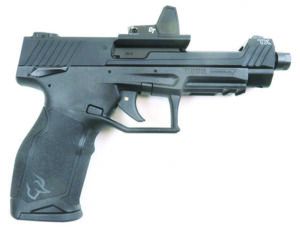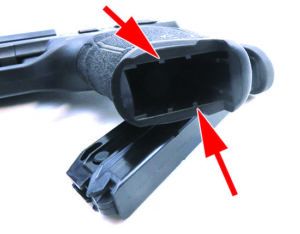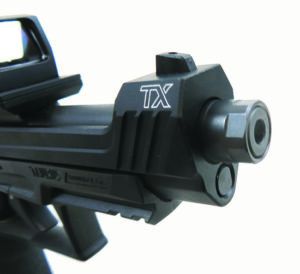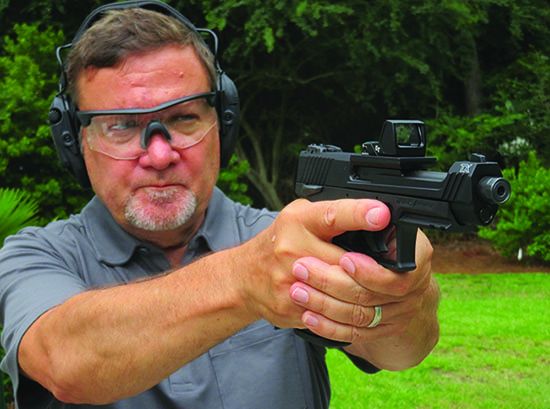Interested in shooting 22 Long Rifle pistols with red dots either at paper targets or steel plates? Ringing steel with smallbore pistols is fun. Some might say addictive. But gearing up for smallbore-pistol target shooting can be confusing because there are many choices between pistols and red-dot optics. Also, putting a ton of money into a 22 LR target pistol might not be in the budget for most shooters, but if you want to play, you’ll still want to invest enough into the pistol and optic to be competitive on the common courses of fire.
For example, one basic set up is to shoot at five to seven steel targets no smaller than 8 inches in size. Five strings are shot, and the four lowest-scored strings are your total score. Even this simple course of fire puts a premium on the gun/optic combo, with the gun needing to be accurate, reliable, and easy to move between targets, and the optic presenting a clear, simple dot that is easy to read and follow target to target.
Accordingly, we wanted to match up suitable pistols with reliable red dots. The pistol budget was set at $450 and the optic budget at $300. The goal was to have a pistol set up for about $800, not including tax and transfer fees. Happily, we came in under budget for all the pistol and optics combos. Going cheap on the red-dot optic is possible because there are many available well under $300. So we went with brands we know and have used in the past. The same was true of 22 LR target pistols. We found a Taurus TX22 Competition for $419, pairing it with a Crimson Trace RAD Micro Pro, $219, with a green dot. Total cost was $718. Middle of the pack was a KelTec CP33 ($469) and an Ultradot 6 ($289) for a total of $758. On the high end was a like-new-in-box used Ruger MK III 22/45 Threaded Barrel for $450, paired with a Shield Sight RMSx, $489, at $789.
How We Tested
Red dots allow the user to shoot with both eyes open for a wide field of view and no tunnel vision aiming. So, for the “action” style of shooting reactive targets, these optics are ideal.
What has not been ideal have been the means of putting optics on handguns, but this process is getting better. Gun manufacturers have made mounting a red dot simple by including mounting plates that are compatible with the footprint of popular optics. For instance, the Crimson Trace RAD Micro Pro has the same footprint as the Shield RMS or JPoint reflex sights. The Ultradot 6, however, mounts like a scope, using rings that clamp onto a Weaver or Picatinny rail. So, as part of our evaluation, we focused on the ease with which we could:
• Mount a red dot on the pistol
• Zero the sight
• Use the dot reticle
• Assess battery life and replacement, and
• Determine a sight’s ruggedness.
For the pistols themselves, we evaluated them on:
• Grip comfort
• Ease of and speed of loading and unloading
• Slide manipulation
• Magazine loading
• Trigger-pull weight
• Balance
• Ability to customize
• Accuracy, and
• Reliability.
Also, because they are target pistols chambered for 22 LR, we looked at field-stripping and cleaning them. Rimfire ammo with lead bullets and dry lube can quickly gunk up an action, so maintenance is important.
Ammo used consisted of two hot high-velocity loads and two mild target loads. On the hot side were CCI AR Tactical rounds with 40-grain copper-coated lead bullets and Federal AutoMatch with a 40-grain lead bullet. On the mild side were Remington Target rounds with 40-grain lead bullets and Eley Tenex with 40-grain lead bullets. All of the ammunition is specifically designed for target shooting and made for use in semi-auto pistols and rifles. Despite them all using 40-grain bullets, results varied by gun.
After we zeroed the sights, we set targets at 20 yards and employed a rest to gauge bench accuracy. For speed shooting and reload manipulations, we used paper plates as targets and set up the course at 10 yards. We then fired Bill Drills — six fast shots inside a small A zone — to see how well the pistols could be fired, controlled, and reloaded.
At the outset, we wondered if we paid too much for the used Ruger/Shield Sight combo or if the mid-priced Taurus/Crimson Trace duo would make a good set up? Was there anything good about the least expensive KelTec/Ultradot set up? Here’s what we found:
Taurus TX22 Competition 1-TX22C151 22 LR
$419
Gun Tests grade: A-
For the price, the TX22 is a great option, though we downgraded it a half point due to the higher trigger-pull weight. The Crimson Trace RAD Micro Pro has a small screen, but it still worked fast.

| Action | Semi-auto |
| Overall Length | 8.1 in. |
| Overall Height | 5.3 in. |
| Maximum Width | 1.2 in. |
| Weight Unloaded | 32.0 oz. |
| Weight Loaded | 33.2 oz. |
| Barrel | 5.2 in. long, 1:16 RH twist, ½-28 tpi muzzle threads |
| Slide | Hard anodized black aluminum |
| Slide Retraction Effort | 11.0 lbs. |
| Frame | Black polymer |
| Frame Front Strap Height | 2.5 in. |
| Frame Back Strap Height | 3.7 in. |
| Grips | Textured polymer |
| Grip Thickness Maximum | 1.2 in. |
| Grip Circumference Maximum | 5.7 in. |
| Front Sight | Fixed blade with white dot |
| Rear Sight | Adjustable, two white dots |
| Sight Radius | 6.7 in. |
| Trigger Pull Weight | 4.7 lbs. |
| Trigger Span | 2.7 in. |
| Magazines | (3) 16 round, polymer with polymer base pad |
| Safeties | Manual thumb, trigger |
| Warranty | Limited lifetime |
| Telephone | (800) 327-3776 |
| Website | TaurusUSA.com |
| Made In | U.S. |
We tested the Taurus TX22 when it was introduced and found it to be an inexpensive, fun-to-shoot pistol with good accuracy. In the hard-plastic case was the TX22 Competition plus three magazines, a loader, and optic plates. Cutouts in the soft foam keep all the accessories separate. We liked having three magazines.
If we did have a gripe, it was the TX22 looked like a bunch of different pistol designs welded together. The grip looks like Walther or H&K had a hand in designing it, and the slide looked like it was a SIG or CZ idea. With the TX22 Competition, the slide looks very much like a Beretta. The slide on the Competition model is open like a Beretta Model 92. The optic mount is attached to the rear of the barrel so the optic does not reciprocate with the slide. The open-top slide reduces the slide weight, so the slide pulse is smoother and less clunky. The open slide also allows you to remove the barrel and attached optic from the slide. No worries about losing zero. This is an excellent setup since the sight stays still while the slide cycles, allowing the user to concentrate on the dot and not be distracted. The barrel is threaded for a compensator or muzzle brake. Taurus offers a Competition model with a compensator for an extra $50. The aluminum slide has forward and aft serrations, and since the optic is mounted to the breech end of the barrel, it doesn’t get in the way when racking the slide, which took about 11 pounds of effort to manipulate.

The grip has a slight palm swell so the handle comfortably fills your hand. The texture on the side panels and straps is like ultra-fine sandpaper without any abrasion. The grip is very comfortable. The trigger guard forms a ridge that guides your trigger finger to the trigger. The magazine catch, which is reversible, is the same height as the ridge. We’d prefer the magazine catch slightly higher. The manual ambidextrous thumb safety can be operated with the thumb of your shooting hand. We’d like the lever a bit larger, but that’s us just quibbling.
The wide and smooth trigger is pretty okay. The trigger pull has three stages. In the first stage, the trigger shoe is rotated to release the trigger safety. In the second stage, which has the most movement, the striker block is raised. In the third stage, you hit the wall and the trigger bar pushes the sear, which releases the striker. Trigger pull when you hit the wall measured 4.7 pounds. Trigger reset is less than a 1⁄4 inch.
The slide stop is small but easy to reach and push down on with your shooting-hand thumb, if you are a right-handed shooter. The polymer magazine tube has a follower with tabs that allow you to compress the magazine spring so you can easily drop cartridges in to load. Not a lot of effort is needed to hold the follower down. The magazine loader helps to load cartridges without requiring the user to pull down on the follower tabs. Either way is quick.

The two optic plates can be flipped, offering up to four different red-dot footprints. The plate fits under the front of the optic, and the rear of the sight attaches to the mount permanently attached to the barrel. The Crimson Trace RAD Micro Pro reflex sight is small and designed for a subcompact EDC pistol. It comes equipped with a green 5-MOA aiming dot that powers off after two minutes of inactivity and turns on instantly when it senses motion. An ambient-light sensor feature automatically adjusts the aiming dot’s brightness to the surrounding lighting condition. We thought this worked well. The sight is made of aluminum and is designed to deflect shock if accidentally dropped. The sight runs on a CR1632 battery, and the sight needs to be removed from the pistol to replace the battery. Battery life is about one year. We prefer not to remove the sight to replace the battery since you need to re-zero the sight. A tiny wrench is included with the optic, and it is needed to adjust the sight. Direction of adjustment is clearly marked.
The location of the mount is above the trigger, and though the Crimson Trace weighs about a half ounce, the weight and location help to mitigate muzzle flip. The pistol is slightly muzzle heavy. Again, there is not much muzzle flip with mild target 22 LR ammo, but we thought the location of the optic was good. Even though the optic is compact, the sight window is fairly large with just the edge of the screen obstructing your view. The green dot was easy to acquire and aim with.
There were no issues with any of the ammo used, which gives you peace of mind with a pistol. Accuracy was good, but not stellar, though plenty good for shooting steel plates. The smallest group was with Federal Auto Match and that measured 0.82 inch. The next best was with CCI AR Tactical with a 0.97-inch group. It was obvious the TX22 liked hotter ammo. The best group with the mild target ammo was with Eley Tenex, and it measured 1.02 inches. The best Remington group measured 1.39 inches. The trigger pull weight was 4.7 pounds, and it felt like it. In our opinion, the pull weight is too much for a target pistol. That said, the trigger could be mastered with more effort. When pressing the trigger, you can feel the three stages.
In hand, the Taurus is light, and recoil and muzzle flip were more noticeable. A compensator would help flatten the pistol during recoil. Still the pistol was fun to shoot. The slide locks back on the last round fired.
In rapid fire the pistol was easy to control and the green dot easy to acquire. The slide cycled smoothly.
The Crimson Trace green dot has a small window as it was designed, yet that did not hinder dot acquisition. The sight is low profile, so it was closer to the bore axis so you do not need to adjust how high or low you hold the pistol to acquire the dot. The brightness of the dot automatically adjusts, and in bright light or in the shade, it popped in the screen. For a dedicated target sight, a manual brightness adjustment would have been appreciated in certain instances.
The TX22 field-strips like a lot of centerfire striker-fire pistols. Pull down on the disassembly latch, pull and release the trigger, then push the slide forward about a 1⁄2 inch, and the slide assembly will come off the grip. You can then remove the recoil assembly from the bottom of the slide and the barrel and optic from the top of the slide.
Our Team Said: The TX22’s trigger-pull weight needs to be lower in our opinion, but other than that, the TX22 performed well with no issues and decent accuracy. If we were to use this gun in competition, we would add a muzzle device to put weight out front and keep the barrel flatter during recoil. The Crimson Trace RAD Micro Pro is a nice sight and paired well with the Taurus.
| 22 LR RANGE DATA | |||
| CCI AR Tactical 40-grain Copper Coated Lead | KelTec CP33 | Ruger MK III 22/45 | Taurus TX22 Competition |
| Average Velocity | 1066 fps | 994 fps | 1040 fps |
| Muzzle Energy | 101 ft.-lbs. | 88 ft.-lbs. | 96 ft.-lbs. |
| Smallest Group | 0.68 in. | 1.37 in. | 0.97 in. |
| Average Group | 0.76 in. | 1.44 in. | 1.09 in. |
| Federal AutoMatch 40-grain Lead | KelTec CP33 | Ruger MK III 22/45 | Taurus TX22 Competition |
| Average Velocity | 1009 fps | 988 fps | 1009 fps |
| Muzzle Energy | 90 ft.-lbs. | 87 ft.-lbs. | 90 ft.-lbs. |
| Smallest Group | 0.65 in. | 0.70 in. | 0.82 in. |
| Average Group | 0.68 in. | 0.76 in. | 0.83 in. |
| Remington Target 40-grain Lead | KelTec CP33 | Ruger MK III 22/45 | Taurus TX22 Competition |
| Average Velocity | 932 fps | 957 fps | 980 fps |
| Muzzle Energy | 77 ft.-lbs. | 81 ft.-lbs. | 85 ft.-lbs. |
| Smallest Group | 0.61 in. | 0.62 in. | 1.39 in. |
| Average Group | 0.70 in. | 0.76 in. | 1.46 in. |
| Eley Tenex 40-grain Lead | KelTec CP33 | Ruger MK III 22/45 | Taurus TX22 Competition |
| Average Velocity | 934 fps | 877 fps | 915 fps |
| Muzzle Energy | 77 ft.-lbs. | 68 ft.-lbs. | 74 ft.-lbs. |
| Smallest Group | 0.52 in. | 1.31 in. | 1.02 in. |
| Average Group | 0.71 in. | 1.55 in. | 1.33 in. |
Written and photographed by Robert Sadowski, using evaluations from Gun Tests Team members. GT





























Love your magazine